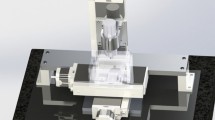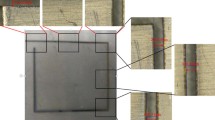Abstract
Assisted magnetic field is an important technique, successfully applied to electrical discharge machining process. In this paper, a comparative study of magnetic field–assisted electrical discharge machining (MF-EDM) has been conducted to process magnetic and non-magnetic materials. Firstly, a series of MF-EDM experiments on selected magnetic material (SKD11) and selected non-magnetic material (Ti6Al4V) were carried out to obtain material remove rate (MRR), surface quality (Ra), and energy efficiency. Then, the influences of magnetic field and servo voltage on machining performance of MF-EDM were completely analyzed under SKD11 and Ti6Al4V. It can be found out that the effects of appropriate magnetic field on two different materials contribute to increasing energy utilization efficiency and MRR under the similar surface roughness. Particularly, MRR of magnetic materials (SKD11) can be improved more significantly than that of non-magnetic materials (Ti6Al4V) due to the smooth debris removal of magnetic materials via Lorenz force acting. These researches could help better understand the effect of magnetic field on the electric discharge machining process of different kinds of materials.












Similar content being viewed by others
References
Klocke F, Klink A, Veselovac D (2014) Turbomachinery component manufacture by application of electrochemical, electro-physical and photonic processes. CIRP Ann Manuf Technol 63(2):703–726
Natsu W, Ojima S, Kobayashi T, Kunieda M (2004) Temperature distributi on measurement in EDM arc plasma using spectroscopy. JSME Int J Ser C Mech Syst Mach Elem Manuf 47(1):384–390
Wang J, Han F, Cheng G (2012) Debris and bubble movements during electrical discharge machining. Int J Mach Tools Manuf 58:11–18
Xu B, Chen S, Liang X (2020) Recast layer removal of 304 stainless steel by combining micro-EDM with negative polarity micro-EDM. Int J Adv Manuf Technol. https://doi.org/10.1007/s00170-020-05312-y
Liu Y, Chang H, Zhang W (2018) A simulation study of debris removal process in ultrasonic vibration assisted electrical discharge machining (EDM) of deep holes. Micromachines 9(8): 378–399
Guo Z, Lee T, Yue T, Lau W (1997) Study on the machining mechanism of WEDM with ultrasonic vibration of the wire. J Mater Process Technol 69:212–221
Yan C, Zou R, Yu Z (2018) Improving machining efficiency methods of micro EDM in cold plasma jet. Procedia CIRP 68:547–552
Yan BH (2004) Improving electrical discharge machined surfaces using magnetic abrasive finishing. Mach Sci Technol 8(1):103–118
Ming W, Jia H, Zhang H, Zhang Z, Liu K, Du J, Shen F, Zhang G (2020) A comprehensive review of electric discharge machining of advanced ceramics. Ceram Int, accepted
Lin YC, Lee HS (2008) Machining characteristics of magnetic force-assisted EDM. Int J Mach Tools Manuf 48:1179–1186
Yan H, Bakadiasa KD, Chen Z (2020) Attainment of high corner accuracy for thin-walled sharp-corner part by WEDM based on magnetic field-assisted method and parameter optimization. Int J Adv Manuf Technol 106:4845–4857
Govindan P (2013) Single-spark analysis of removal phenomenon in magnetic field assisted dry EDM. J Mater Process Technol 213(7):1048–1058
Ming WY, Zhang Z, Wang SY, Zhang YM, Shen F, Zhang GJ (2019) Comparative study of energy efficiency and environmental impact in magnetic field assisted EDM and conventional EDM. J Clean Prod 214:12–28
Zhang Z, Huang H, Ming WY, Xu Z, Huang Y, Zhang GJ (2016) Study on machining characteristics of WEDM with ultrasonic vibration and magnetic field assisted techniques. J Mater Process Technol 234:342–352
Zhang Y, Zhang Z, Zhang GJ, Li W (2020) Reduction of energy consumption and thermal deformation in WEDM by magnetic field assisted technology. Int J Pr Eng Man-GT 7(2):391–404
Shabgard MR, Gholipoor A, Mohammadpourfard M (2019) Investigating the effects of external magnetic field on machining characteristics of electrical discharge machining process, numerically and experimentally. Int J Adv Manuf Technol 102:55–65
Teimouri R, Baseri H (2012) Experimental study of rotary magnetic field-assisted dry EDM with ultrasonic vibration of workpiece. Int J Adv Manuf Technol 67(5-8):1371–1384
Teimour R, Baseri H (2012) Effects of magnetic field and rotary tool on EDM performance. J Manuf Process 14(3):316–322
Teimour R, Baseri H (2014) Optimization of magnetic field assisted EDM using the continuous ACO algorithm. Appl Soft Comput 14:381–389
Lin YC (2009) Optimization of machining parameters in magnetic force assisted EDM based on Taguchi method. J Mater Process Technol 209(7):3374–3383
Heinz K (2011) An investigation of magnetic-field-assisted material removal in micro-EDM for nonmagnetic materials. J Manuf Sci Eng 133(2):021002
Heinz JR, Kenneth G (2010) Fundamental study of magnetic field-assisted micro-EDM for non-magnetic materials (Ph.D. Thesis). University of Illinois at Urbana Champaign
Jafferson JM, Hariharan P, Ram Kumar J (2014) Effects of ultrasonic vibration and magnetic field in micro-EDM milling of nonmagnetic material. Mater Manuf Process 29(3):357–363
Chen Z, Zhang Y, Zhang G (2017) Theoretical and experimental study of magnetic-assisted finish cutting ferromagnetic material in WEDM. Int J Mach Tools Manuf 123:36–47
Chen Z, Yan Z, Yan H, Han F (2019) Improvement of the machining characteristics in WEDM based on specific discharge energy and magnetic field-assisted method. Int J Adv Manuf Technol 103 (5–8):3033–3044
Yang X D, Tian J (2019) High-speed video observation of molten pool and material erosion during single-pulse discharge. In: Papers Collection of the 18th National Academic Conference on Special Processing, (1), pp 80–87
Joshi S (2011) Experimental characterization of dry EDM performed in a pulsating magnetic field. CIRP Ann Manuf Technol 60(1):239–242
Sakamoto Y (2013) Construction and performance test of improved magnetic field stabilization system for EDM measurement. In: International Nuclear Physics Conference, INPC
Govindan P (2013) Single-spark analysis of removal phenomenon in magnetic field assisted dry EDM. J Mater Process Technol 213(7):1048–1058
Zhang R, Chen M, Yan X, Zhao W (2019) Observation of movement law of discharge products in EDM lateral feeding process. In: Papers Collection of the 18th National Academic Conference on Special Processing, vol 1, pp 73–79
Yu W (2007) Calculation of magnetic force of permanent magnet devices. Journal of Magnetic Materials and Devices 5:49–53. In Chinese
Adler R, Anderson W (1990) Force between a superconductor and a permanent magnet due to trapped flux. J Appl Phys 68(2):695–700
Acknowledgments
Prof. Zhang Guojun’s research team provides us with a simulation model and results in the process of magnetic field–assisted EDM in Section 3.
Funding
This research is supported by the National Natural Science Foundation of China (Grant Nos. 51705171 and 51505434). In addition, this research is supported by the Natural Foundation of Henan Province (Grant No. 182300410170).
Author information
Authors and Affiliations
Corresponding author
Ethics declarations
Compliance with Ethical Standards
On behalf of and having obtained permission from all the authors, I declare that:
-
1.
The manuscript has not been submitted to more than one journal for simultaneous consideration.
-
2.
The manuscript has not been published previously (partly or in full), unless the new work concerns an expansion of previous work (please provide transparency on the re-use of material to avoid the hint of text-recycling (“self-plagiarism”)).
-
3.
A single study is not split up into several parts to increase the quantity of submissions and submitted to various journals or to one journal over time (e.g., “salami-publishing”).
-
4.
No data have been fabricated or manipulated (including images) to support your conclusions
-
5.
No data, text, or theories by others are presented as if they were the author’s own (“plagiarism”). Proper acknowledgements to other works must be given (this includes material that is closely copied (near verbatim), summarized and/or paraphrased), quotation marks are used for verbatim copying of material, and permissions are secured for material that is copyrighted.
-
6.
Consent to submit has been received explicitly from all co-authors, as well as from the responsible authorities—tacitly or explicitly—at the institute/organization where the work has been carried out, before the work is submitted.
-
7.
Authors whose names appear on the submission have contributed sufficiently to the scientific work and therefore share collective responsibility and accountability for the results.
Conflict of interest
The authors declare that there are no conflicts of interest.
Additional information
Publisher’s note
Springer Nature remains neutral with regard to jurisdictional claims in published maps and institutional affiliations.
Rights and permissions
About this article
Cite this article
Ming, W., Shen, F., Zhang, Z. et al. A comparative investigation on magnetic field–assisted EDM of magnetic and non-magnetic materials. Int J Adv Manuf Technol 109, 1103–1116 (2020). https://doi.org/10.1007/s00170-020-05653-8
Received:
Accepted:
Published:
Issue Date:
DOI: https://doi.org/10.1007/s00170-020-05653-8




